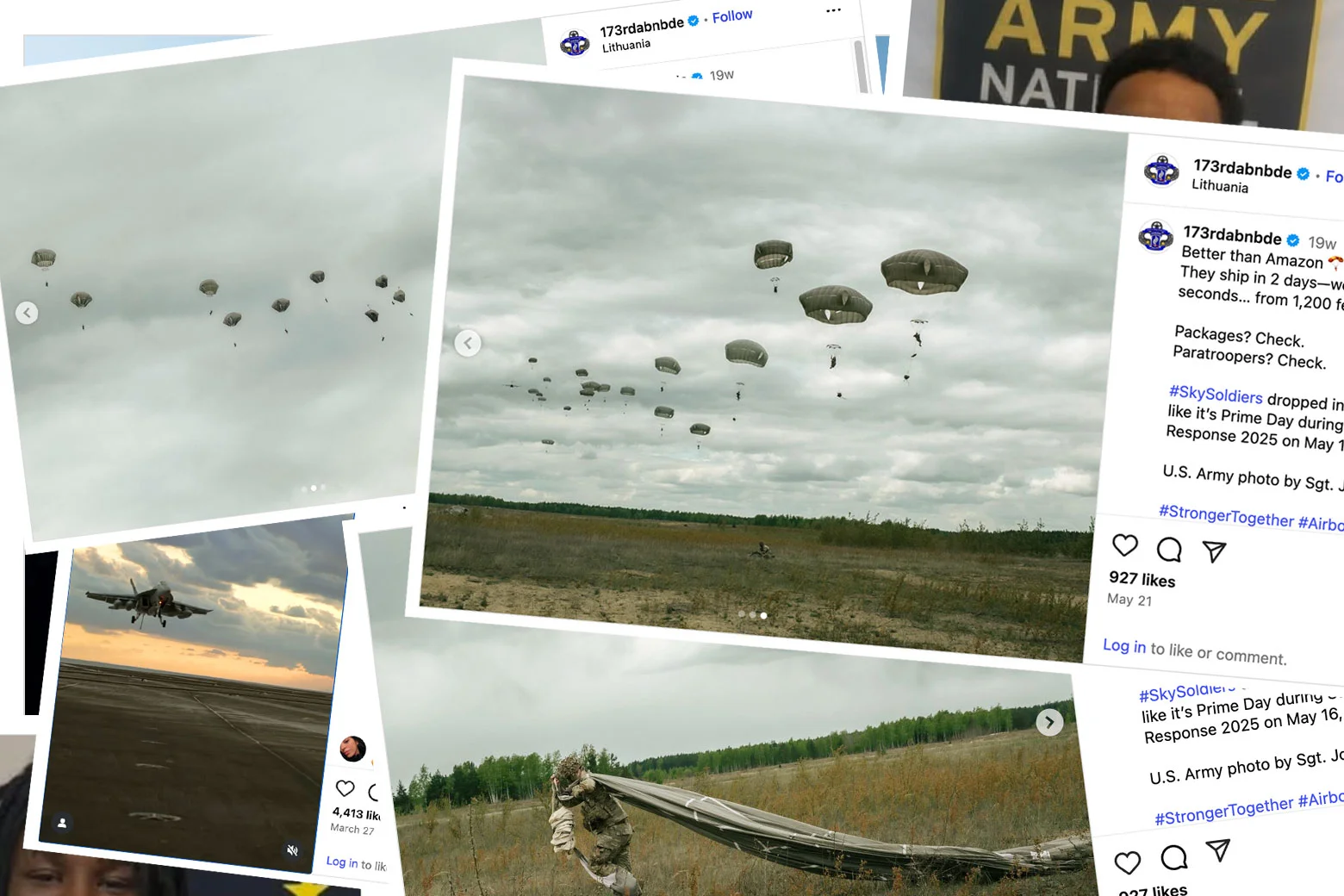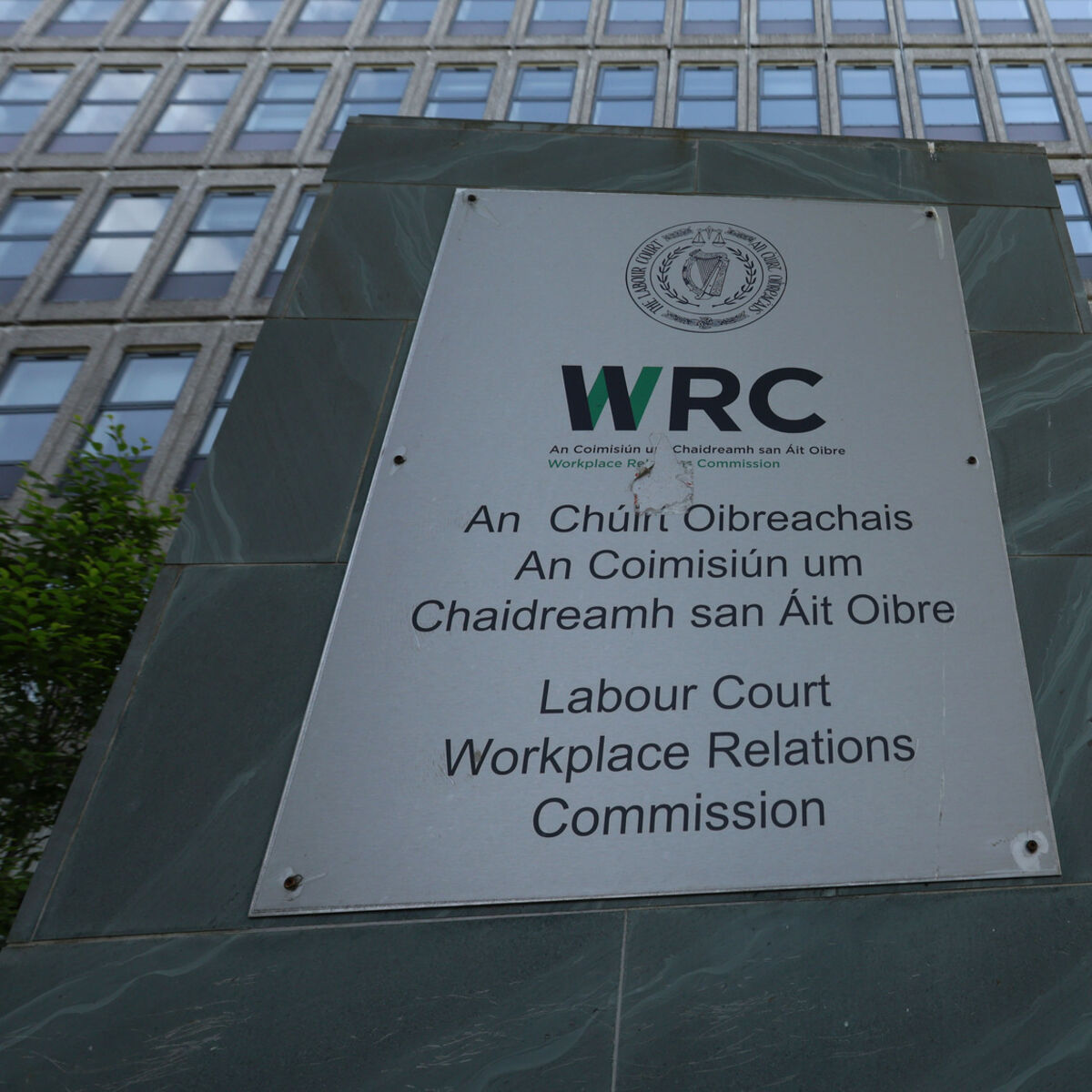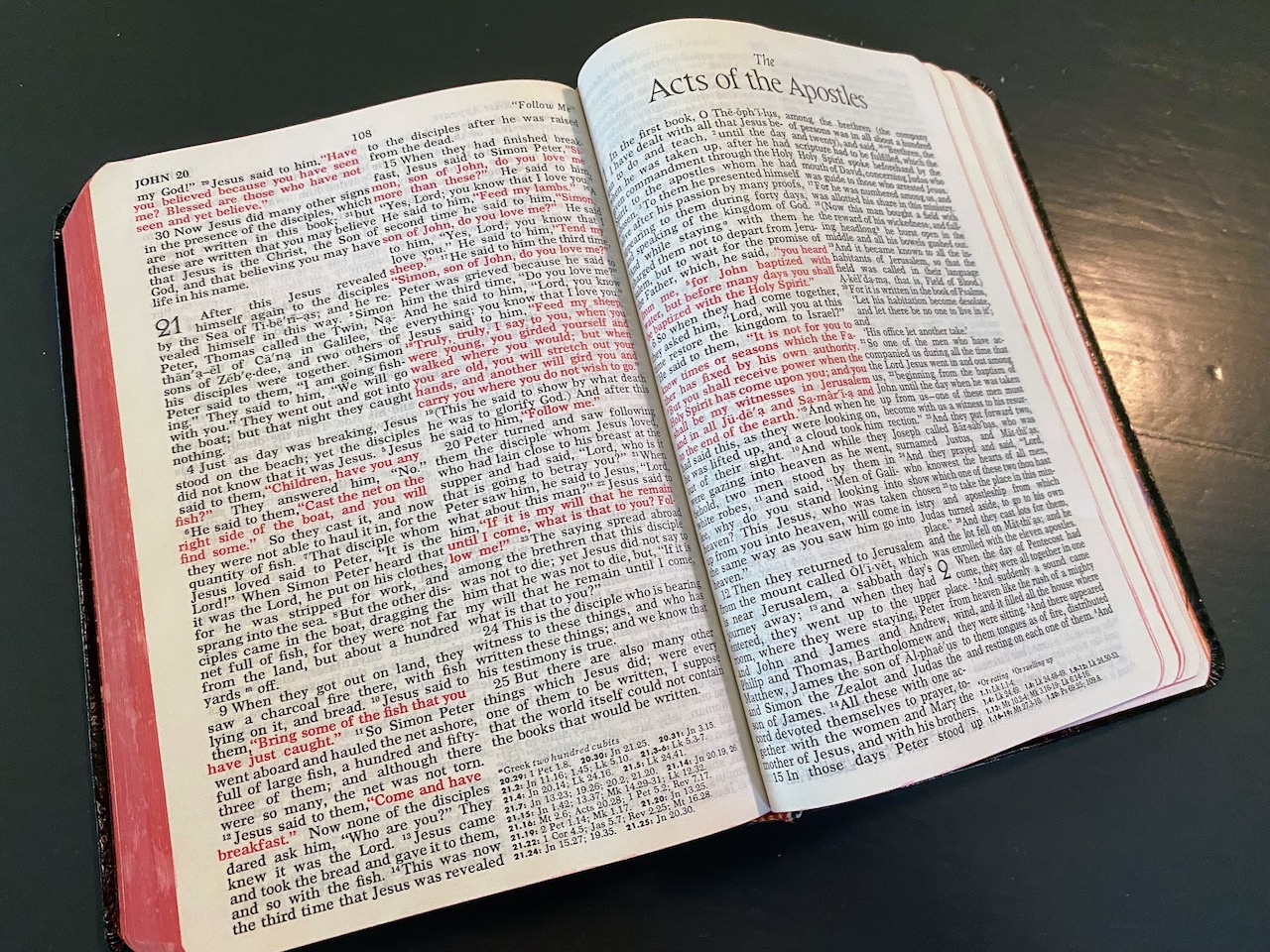
Sign up for the Slatest to get the most insightful analysis, criticism, and advice out there, delivered to your inbox daily.
For the past 49 days, the National Guard has occupied the nation’s capital. President Trump’s order of the guard to Washington, initially announced as a short-term move to fight crime, has turned into a mandate for near-indefinite presence. Guard members from other states assigned to Joint Task Force-D.C. are now rotating through assignments, akin to an overseas mission. On Monday, Trump announced 100 National Guard troops would be sent to Chicago. As Trump made clear in his pep-rally assembly of the military’s generals and admirals on Tuesday, there will be many more deployments to America’s cities to come: “We’re going to straighten them out one by one. And this is going to be a major part for some of the people in this room. That’s a war, too.”
While critics pointed out how unprecedented and worrisome this was, on Instagram, the military units at the grim epicenters of these political controversies have been busily posting a very different reality. After the Georgia National Guard was ordered to send fresh troops to D.C., it published a cheery post with no mention of its new mission. Instead, it offered two pictures of new recruits with the caption:
🚨 NEW SOLDIER ALERT! 🚨
Congratulations to the newest warriors joining the Georgia Army National Guard! 💪🇺🇸 Welcome to the team—your journey of service, strength, and success starts now. Let’s give them a big Guard family welcome! 🎉👏
The increasingly standard use of social media by the military has created a surreal contrast between the public face that many units present online and the reality of their deployments. While the Trump administration has thrust the military into domestic political firestorms, unit social media accounts have steadily kept up a stream of upbeat posts on their Instagram and Facebook pages. Scrolling through the D.C. National Guard’s Facebook page is an exercise in cognitive dissonance: videos of arrests, followed by pictures of guard troops picking up trash. Low-budget videos of guard members talking about the NFL, next to photo dumps of armed soldiers on patrol in the subway. While National Guard leaders say they have sought to maintain “positive” interactions with the public, there is a growing rupture between the chummy online persona of its units and the operations that they are being asked to carry out.
The tonal disconnect goes beyond the National Guard. For several years, military units on Instagram, Facebook, and YouTube have waged their own public relations battles. Operating at a lower level, their socials have blended memes, internet vernacular, slice-of-life vlogs, and small doses of military brouhaha into innocuous streams of content. The result is like something out of the 1997 Paul Verhoeven satire Starship Troopers, where smiling personalities present a cheerful view of what it’s like to do your part for the most powerful military on earth.
Through their posts, which rely heavily on memes and emoji, the American war machine has in recent years sought to frame itself as mundane and relatable. This has led to many a “cringe” post, some created by accident and others on purpose. It is far from the stern image of Uncle Sam in WWI Army recruiting posters, or the muscular TV recruitment ads of the early 2000s.
Why has the military taken to social media, and why do their posts sound the way that they do? There is, certainly, an effort to boost recruitment. But behind the posts, the emoji, and the memes, there is an enduring identity problem the U.S. military has struggled to resolve. Social media is merely the latest battle in a campaign that has lasted half a century, as our military has tried to straddle a fundamental cultural disconnect between whether it is an accessible, civilianized professional force, of no harm to democratic life, or an institution of pure martial prowess.
In May, the 173rd Airborne Brigade participated in Swift Response 2025, a multinational training exercise designed to test NATO’s response to a possible invasion of Lithuania.
The brigade also took to social media, posting pictures of paratroopers floating down through a gray sky with a cheerful caption joking about the speed of their response:
Most major U.S. military units now maintain a social media presence, from central commands to logistics ships. It’s a decentralized, vast military public relations effort that, in total, could reach a larger audience than a Super Bowl ad.
Individual U.S. military units began using social media in the late 2010s as a way to disseminate information. In 2009, NATO’s supreme allied commander of Europe, a U.S. Navy admiral, used a blog post to share his goals for his tenure. The military didn’t yet see social media as a way to convince, or to sell an image of what it was like to serve. Through the 2010s, the Pentagon and the military branches developed social media policies primarily intended to define proper and improper use. Operational security was the central concern.
It was only in 2022 that the Defense Department offered guidance on how to use social media as a proactive communication tool. The 2022 guidance called for “content that should inspire and engage with audiences” and for public affairs personnel to “proactively maintain currency in the latest social media tactics, best practices, and trends.” With the power of public messaging now democratized to every unit, the Defense Department encouraged social media managers to consider the full suite of internet content strategies available to them. Its central maxim was that social media could enhance “the public trust,” putting authenticity and a human face on military work.
By 2024, the most popular social media military performers were lauded for their contributions to the success of individual operations. The commanding officer of the USS Dwight D. Eisenhower, Capt. Chris “Chowdah” Hill, gained hundreds of thousands of followers by consistently posting upbeat messages throughout a 2023–24 combat deployment in the Red Sea. Hill’s social media efforts focused on ship life, as he posted about mealtime or the ship’s therapy dog, and earned widespread praise as an example of effective military communication.
That pattern continued during the intense Red Sea bombing campaign from March to May of this year. That operation burned through over $1 billion in munitions in the first month of bombing of alone, in one of the riskiest operations the Navy has had to carry out in recent years. Meanwhile, the aircraft carriers involved used their social media accounts to describe the situation in jaunty, cheerful terms. Two weeks before deployment to the Red Sea, on March 27, 2025, the official account for the USS Carl Vinson posted: “Who has two thumbs and is a ready capable force?! 👍👍”
The fact that the sweeping network of military social media is managed at the unit level means that the posts range widely in tone. The 1st Armored Division, for example, somberly sticks to what could be described as “tank porn” and training montages. Marine Corps units have also typically stuck to martial imagery, befitting the branch’s historical focus on traditional masculine themes. But many other accounts lean hard into showcasing the lighter side of military life.
Emoji appear key to this effort at relatability. There’s quantitative evidence that shows just how much military social media uses them. Analyzing posts from three U.S. Navy aircraft carriers, the Carl Vinson, Harry Truman, and Gerald Ford, from April 2023 to June 2025, I found that those three accounts used 2,725 emoji across hundreds of posts. For comparison, across the same time period, three University of Alabama sororities—Zeta Tau Alpha, Pi Beta Phi, and Alpha Phi—posted a total of 1,800 emoji. There were vastly more ❤️s and ✨s at Alabama, to be fair, but the comparison offers perspective. The U.S. Navy is out-emojiing some of the most popular sororities in the country, buoyed by a ship’s worth of ⚓️, 🎉, and 💪 emoji. Even Marine Corps unit accounts, which keep to familiar military aesthetics, flood their captions with emoji.
Dogs are another prominent arrow in the military public relations quiver. When Capt. Rudder, a Labrador therapy dog, arrived on the aircraft carrier the USS Carl Vinson in December 2024, the ship rolled out the red carpet. He arrived off a helicopter with goggles and ocean-colored booties, along with a press release, special-edition merchandise, and—of course—a personal Instagram account.
Rudder is not alone—”Commander Ike” of the USS Wasp has 60,000 followers on Instagram, with an account that typically posts about everyday ship life and the Labrador retriever’s adventures. The 3rd Armored Brigade Combat Team has a mascot bulldog, Staff Sgt. Chester, who headlines their Facebook page (whoever runs that page, as an aside, had some seriously wild photoshop skills back in 2021—let us mourn this dying art, in the age of A.I.). Even the 1st Armored Division, which overall broadcasts a serious image, can’t help but put its unit dog under the stage lights on occasion. Sometimes, the dog posts flit away from memes and hint at much more serious geopolitical principles. An Instagram post from the USS Carl Vinson announcing Rudder’s arrival aboard offered a well-edited video captioned with the hashtag “#FreeandOpenIndoPacific.”
In her 2008 book America’s Army, historian Beth Bailey charts the transformation of the U.S.
Army after the Vietnam War, as it transitioned from relying on conscripts to being an all-volunteer force. To revarnish a military whose reputation had been torn asunder by the controversies of Vietnam, the Army turned to marketing and reforms. By doing away with patriotic calls to duty and replacing them with advertisements that dangled its benefits, like free college or the opportunity to see Europe, Army leaders helped save the branch from a recruiting tailspin.
Those advertising strategies effectively civilianized the military, making everyday life in uniform appear less daunting, sanding down its rougher edges, recalibrating the idea of the soldier into that of a citizen with a job. While recruiting did briefly spike after Sept. 11, by 2004 the military already faced recruitment shortfalls in a War on Terror that reminded the public of the danger involved with military service. As War on Terror deployments petered out, the Army and Navy both switched back toward ads that civilianized the idea of service. In 2019, the Army pushed a “What’s Your Warrior?” campaign, evoking a “choose your own adventure” and job-centric theme to reach Gen Z recruits. The Navy, too, began hiring YouTubers to highlight its work as techy and applicable to future high-paying civilian careers.
Social media was certainly about recruiting, but it was also about creating harmony within the ranks. Prior to January 2025, military social media continued to trend toward the central axiom of the 2022 directive of centering authenticity and the human. Sgt. Maj. Michael Grinston, who retired in 2023, used his platform to air out complaints from enlisted Army personnel, taking to Reddit and Twitter to have conversations about race, living conditions, and military culture.
West Point, too, used Instagram as a way to reach a Gen Z audience. Most of West Point’s social media focus on milestones and cadet training. But when it offered a tongue-in-cheek video last December to celebrate the annual rivalry game with the Naval Academy, the account encapsulated all of the possibilities of military social media: a golden retriever in the thumbnail to vacuum up clicks, a stream of grizzled military leaders using Gen Z slang (including a lieutenant general saying “the vibes are immaculate”), and a caption that read “Serving looks AND the nation. 🫡🔥.” I gasped, gaped, and guffawed when I saw the video. It was, in short, the perfect post, with something for everyone: the cadets, the Army, and the public.
Carmine Cocchia, chief of the Visual Information division of West Point’s Media Relations team, said in an interview that the idea behind that video was to grab attention, reach a younger audience, and to show off West Point as a cool place to be. “Everybody loves dogs,” Cocchia said.
But some of these higher-level messages, aimed at reaching a wider range of Americans, have drawn the ire of right-wing influencers and politicians. Diversity messages in recruitment ads led critics to accuse the military of becoming “woke” and “emasculated.” In the second Trump administration, top-level military advertising has shifted toward images of violence, aggression, and combat, while Pentagon chief Pete Hegseth has called for a focus on “lethality.”
In March, many unit accounts began posting a similar message online: an announcement that they had removed old posts and adjusted their content to align with recent executive orders. The March announcements reference recent Pentagon policy changes driven by Executive Order 14168, which eliminated protections for transgender individuals. It is likely that any trans service member previously highlighted on a social media account was wiped from the digital record.
There have been other tonal shifts in recent months as some accounts have appeared to react to top-down guidance. The USS Gerald R Ford once kept up a very campy, yet charming “Wolverine of the week” series on Instagram that prominently showcased individual crew members and their jobs. Since June, its posts have shifted to hardware—jet fighters and ships at sea, any sailors safely at a distance, encased in helmets and goggles that obscure their personality. “We closely align ourselves with what the Army is doing,” stated Cocchia. “We take the lead from the Army.” On plans for content for the upcoming Army–Navy rivalry game this December, Cocchia replied that “We want our video to resonate with the entire Army,” adding, “It may not have a dog in it.”
There still exists an inherent disconnect with the Trump administration’s focus on lethality. U.S. Army guidelines encourage its social media managers to maintain “a dynamic and engaging social presence.” For many unit accounts, that means there are incentives to keep a chipper, lighthearted online attitude, even as the context around missions darkens with the political climate. National Guard accounts show these inflections most clearly. The California National Guard, for example, posted a SpongeBob meme about the weather on the same day that an appeals court upheld Trump’s controversial federalization of the guard against the wishes of California Gov. Gavin Newsom. At the end of August, as Trump began to threaten to send National Guard units to Democrat-led cities like Chicago, the Illinois Guard account offered up a meek meme which played on Taylor Swift and Travis Kelce’s engagement.
No matter how cringey the world of military social media has been over the past few years, or how much the cheesy memes and therapy-dog content have papered over the sometimes grisly side of military work, the collective vibe of cheerfulness was ultimately comforting. Before January 2025, these accounts were creating a communal image of the military as a friendly, democratic institution full of people not too dissimilar from the American public. As the military under Trump takes on border and policing duties, as thousands of guard members get called away from their day jobs for service, as military bases become staging centers for federal law enforcement, and some military social media accounts return to lifeless themes of lethality, what’s left is merely terrifying.



